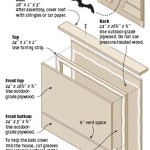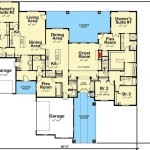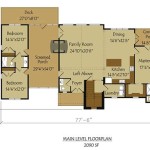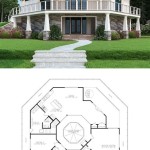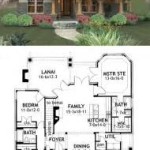Design House Floor Plans: Create Your Dream Home
Designing a house floor plan represents a crucial initial step in the home-building process. It is the blueprint, the foundation upon which the entire structure and living experience will be built. A well-designed floor plan ensures that the home meets the specific needs and lifestyle of its inhabitants, optimizing space, functionality, and aesthetics. The process involves careful consideration of various factors, including the size and shape of the lot, the orientation of the building, building codes, budget constraints, and personal preferences.
The importance of a thoughtfully conceived floor plan cannot be overstated. It dictates the flow of movement within the home, the placement of essential rooms, and the overall ambiance. A poorly designed floor plan can lead to wasted space, awkward layouts, and ongoing dissatisfaction. Conversely, a well-executed plan maximizes living space, promotes efficiency, and creates a comfortable and inviting environment.
The initial phase of designing a house floor plan typically involves defining the needs and wants of the homeowners. This requires a detailed assessment of their lifestyle, family size, hobbies, and future plans. Key considerations include the number of bedrooms and bathrooms required, the need for dedicated office space, the desired size of the kitchen and living areas, and the potential for future expansion.
Once the basic requirements are established, the design process can proceed. This may involve working with an architect, a building designer, or utilizing specialized software programs to create detailed floor plans. The chosen method often depends on the complexity of the project and the budget available. Architects and building designers bring expertise and experience to the table, offering creative solutions and ensuring compliance with building regulations. Software programs provide users with the tools to create their own floor plans, albeit with a steeper learning curve and potentially less professional guidance.
Key Elements of Effective Floor Plan Design
Effective floor plan design incorporates several key elements to ensure functionality, comfort, and aesthetic appeal. These elements are not mutually exclusive and often interact to create a harmonious living space.
One of the most important considerations is the flow of traffic within the home. The floor plan should facilitate easy movement between different areas, minimizing obstacles and bottlenecks. Circulation paths should be direct and intuitive, allowing inhabitants to move freely without feeling cramped or confined. This is particularly important in high-traffic areas such as the entryway, kitchen, and living room.
Another vital aspect is the segregation of different zones within the house. The floor plan should clearly differentiate between private areas, such as bedrooms and bathrooms, and public areas, such as the living room and dining room. This separation ensures privacy and tranquility in the private zones while promoting social interaction in the public areas. Noise reduction strategies, such as strategically placing walls and using sound-absorbing materials, can further enhance this segregation.
The orientation of the house on the lot is also a critical factor. The floor plan should take into account the direction of sunlight and prevailing winds. This can impact the energy efficiency of the home and the comfort of its inhabitants. For instance, large windows facing south can maximize solar heat gain in the winter, while strategically placed trees can provide shade in the summer. Proper orientation can significantly reduce heating and cooling costs, contributing to a more sustainable and comfortable living environment.
Beyond these fundamental elements, the floor plan should also reflect the aesthetic preferences of the homeowners. This may involve incorporating architectural details, such as high ceilings, large windows, or open floor plans, to create a specific ambiance. The choice of materials, colors, and finishes can further enhance the overall aesthetic appeal of the home.
Factors Influencing Floor Plan Design
Numerous factors can influence the design of a house floor plan. These factors can be broadly categorized as site considerations, building codes, budget constraints, and personal preferences.
Site considerations encompass the physical characteristics of the lot, including its size, shape, slope, and orientation. The floor plan must be adapted to the specific constraints of the site. For instance, a sloped lot may require a split-level design or extensive landscaping to ensure proper drainage. Similarly, a narrow lot may necessitate a vertical layout or a compact floor plan.
Building codes are a set of regulations that govern the construction of buildings. These codes are designed to ensure the safety and structural integrity of the building, as well as to protect the health and welfare of its occupants. The floor plan must comply with all applicable building codes, including requirements for fire safety, accessibility, and energy efficiency. Failure to comply with building codes can result in costly delays and fines.
Budget constraints are a reality for most home-building projects. The floor plan must be designed within the available budget. This may involve making trade-offs between size, features, and materials. For instance, reducing the overall square footage of the house or opting for more affordable finishes can help to keep costs under control. It is important to prioritize essential features and to explore cost-effective design solutions.
Personal preferences play a significant role in shaping the floor plan. The floor plan should reflect the unique needs and lifestyle of the homeowners. This may involve incorporating specific features, such as a home theater, a wine cellar, or a dedicated art studio. The layout of the rooms and the overall flow of the house should also be tailored to the homeowners' preferences. It is essential to communicate these preferences clearly to the architect or building designer.
Tools and Resources for Designing Floor Plans
Several tools and resources are available to assist in the design of house floor plans. These resources range from traditional drafting methods to sophisticated computer-aided design (CAD) software.
Traditional drafting methods involve using paper, pencils, rulers, and other drafting tools to create hand-drawn floor plans. This method is still used by some architects and building designers, particularly for preliminary sketches and conceptual designs. While it requires a certain level of skill and expertise, it offers a high degree of flexibility and control.
CAD software programs provide a digital platform for creating detailed floor plans. These programs offer a wide range of features, including the ability to draw walls, insert doors and windows, add furniture, and generate 3D models. CAD software programs are widely used by architects, building designers, and construction professionals. They offer a high degree of accuracy and efficiency, and they allow for easy modification and collaboration.
Online floor plan design tools provide a user-friendly interface for creating basic floor plans. These tools are often web-based and require no special software installation. They typically offer a limited set of features compared to CAD software programs, but they can be a useful option for homeowners who want to create a simple floor plan on their own. Some online tools also offer pre-designed floor plans that can be customized to suit specific needs.
In addition to these tools, there are numerous online resources available to help with the floor plan design process. These resources include articles, tutorials, and forums that provide information and advice on various aspects of floor plan design. Visiting model homes and browsing through home design magazines can also provide inspiration and ideas.
Selecting the appropriate tool or resource largely depends on the level of complexity of the project, the user's technical skills, and the budget available. For simple projects, online floor plan design tools may suffice. However, for more complex projects, professional assistance from an architect or building designer is typically recommended.
Ultimately, the goal of designing a house floor plan is to create a living space that is both functional and aesthetically pleasing. By carefully considering the various factors that influence floor plan design and utilizing the appropriate tools and resources, homeowners can create a dream home that meets their specific needs and reflects their unique lifestyle.

My Dream House Free Online Design 3d Ideas By Planner 5d

Create And Visualize House Plans In Minutes Roomsketcher

Build Your Dream Home With These 13 Hot New House Plans Blog Dreamhomesource Com

Find A Custom Home Plan Dream Construction

How To Come Up With The Best Floor Plan For Your Dream House Innodez

What Makes A Good Floor Plan

Get Customized House Plan Design Floor

Make Your Dream House Floor Plans By Architect Rehan Fiverr

Complete Floor Plan For Your Dream Home Using Autocad Upwork

Create And Visualize House Plans In Minutes Roomsketcher
Related Posts

